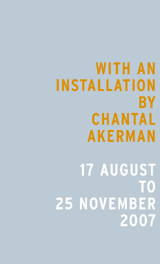"Life? or Theatre?": Main Section
Second part of the cycle by Charlotte Salomon



- Pictures (top to bottom):
Paulinka Bimbam and the voice teacher Amadeus Daberlohn: "So we are supposed to work together?", from "Life? or Theatre? ", sheet 4378.
Daberlohn would like to make Paulinka the greatest singer in the world: "Yes, I present to the world its greatest singer. Worship me for this - I am your savior!", from "Life? or Theatre?", sheet 4385.
Daberlohn and Charlotte set out on a boat trip, DABERLOHN: "This is my new religion", from "Life? or Theatre?", sheet 4697r.
© (for all pictures) Charlotte Salomon Foundation, Amsterdam
Red: "Main Section"
In the red part the characters Charlotte Kann, the singer Paulinka Bimbam and the voice teacher Amadeus Daberlohn play the main roles. A conflict-ridden complex of relationships develops between them. In the first half the voice teacher Daberlohn adores the singer Paulinka. Charlotte falls in love with the voice teacher and Daberlohn increasingly turns his attentions to Charlotte.
Instead of writing her texts for this part on tracing paper, Charlotte painted them into the pictures. The text becomes a characteristic element of the picture. When a character speaks, that character's face appears on a series of sheets. For loquacious Daberlohn's monologues she resorts to a special design element: his flow of words spans several pictures. In longer sequences it is distributed over many sheets.
Contents
The voice teacher Amadeus Daberlohn (Alfred Wolfsohn) appears. He is supposed to work as répétiteur, as piano accompanist, for Paulinka Bimbam's rehearsals. He is enthralled by Paulinka and wants to apply his theories of vocal training to mold her into the best singer in the world. Paulina doesn't think much of his ideas, though.
Daberlohn does make a great impression on Charlotte, however. His devotion and encouragement inspire her artistic ambition and her heart. Initially Daberlohn sees in Charlotte merely a suitable object for his theories about the soul and artistic expression. Charlotte and Daberlohn become better acquainted. She falls in love with him.
Now the secret love affair between Charlotte and Daberlohn begins. They meet for a boat trip and make love.
In the night of the pogroms, 9 November 1938, when synagogues and Jewish businesses in Germany are destroyed and Jews detained, Charlotte's father is among those arrested. He is sent to the Sachsenhausen concentration camp. With great effort, and thanks only to her good contacts, Paulinka manages to get him released. Life for Jews has become too dangerous in Germany. Charlotte is sent to her grandparents in the south of France. Paulinka and Albert decide to leave the country as well.
A catalog of the exhibition has been published.
When: 17 August to 25 November 2007,
daily from 10 to 8, Mondays to 10 (closed: 9/13+14, 9/22, 9/25, 11/17/2007)
Where: Jewish Museum Berlin, Lindenstrasse 9-14, 10969 Berlin
An exhibition of the Jewish Museum Berlin in collaboration with Joods Historisch Museum Amsterdam.


